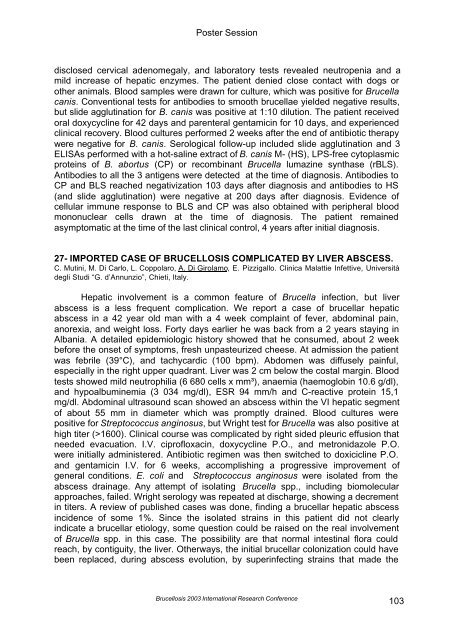Brucellosis 2003 proceedings - PHIDIAS
Brucellosis 2003 proceedings - PHIDIAS
Brucellosis 2003 proceedings - PHIDIAS
Create successful ePaper yourself
Turn your PDF publications into a flip-book with our unique Google optimized e-Paper software.
Poster Session<br />
disclosed cervical adenomegaly, and laboratory tests revealed neutropenia and a<br />
mild increase of hepatic enzymes. The patient denied close contact with dogs or<br />
other animals. Blood samples were drawn for culture, which was positive for Brucella<br />
canis. Conventional tests for antibodies to smooth brucellae yielded negative results,<br />
but slide agglutination for B. canis was positive at 1:10 dilution. The patient received<br />
oral doxycycline for 42 days and parenteral gentamicin for 10 days, and experienced<br />
clinical recovery. Blood cultures performed 2 weeks after the end of antibiotic therapy<br />
were negative for B. canis. Serological follow-up included slide agglutination and 3<br />
ELISAs performed with a hot-saline extract of B. canis M- (HS), LPS-free cytoplasmic<br />
proteins of B. abortus (CP) or recombinant Brucella lumazine synthase (rBLS).<br />
Antibodies to all the 3 antigens were detected at the time of diagnosis. Antibodies to<br />
CP and BLS reached negativization 103 days after diagnosis and antibodies to HS<br />
(and slide agglutination) were negative at 200 days after diagnosis. Evidence of<br />
cellular immune response to BLS and CP was also obtained with peripheral blood<br />
mononuclear cells drawn at the time of diagnosis. The patient remained<br />
asymptomatic at the time of the last clinical control, 4 years after initial diagnosis.<br />
27- IMPORTED CASE OF BRUCELLOSIS COMPLICATED BY LIVER ABSCESS.<br />
C. Mutini, M. Di Carlo, L. Coppolaro, A. Di Girolamo, E. Pizzigallo. Clinica Malattie Infettive, Università<br />
degli Studi “G. d’Annunzio”, Chieti, Italy.<br />
Hepatic involvement is a common feature of Brucella infection, but liver<br />
abscess is a less frequent complication. We report a case of brucellar hepatic<br />
abscess in a 42 year old man with a 4 week complaint of fever, abdominal pain,<br />
anorexia, and weight loss. Forty days earlier he was back from a 2 years staying in<br />
Albania. A detailed epidemiologic history showed that he consumed, about 2 week<br />
before the onset of symptoms, fresh unpasteurized cheese. At admission the patient<br />
was febrile (39°C), and tachycardic (100 bpm). Abdomen was diffusely painful,<br />
especially in the right upper quadrant. Liver was 2 cm below the costal margin. Blood<br />
tests showed mild neutrophilia (6 680 cells x mm³), anaemia (haemoglobin 10.6 g/dl),<br />
and hypoalbuminemia (3 034 mg/dl), ESR 94 mm/h and C-reactive protein 15,1<br />
mg/dl. Abdominal ultrasound scan showed an abscess within the VI hepatic segment<br />
of about 55 mm in diameter which was promptly drained. Blood cultures were<br />
positive for Streptococcus anginosus, but Wright test for Brucella was also positive at<br />
high titer (>1600). Clinical course was complicated by right sided pleuric effusion that<br />
needed evacuation. I.V. ciprofloxacin, doxycycline P.O., and metronidazole P.O.<br />
were initially administered. Antibiotic regimen was then switched to doxicicline P.O.<br />
and gentamicin I.V. for 6 weeks, accomplishing a progressive improvement of<br />
general conditions. E. coli and Streptococcus anginosus were isolated from the<br />
abscess drainage. Any attempt of isolating Brucella spp., including biomolecular<br />
approaches, failed. Wright serology was repeated at discharge, showing a decrement<br />
in titers. A review of published cases was done, finding a brucellar hepatic abscess<br />
incidence of some 1%. Since the isolated strains in this patient did not clearly<br />
indicate a brucellar etiology, some question could be raised on the real involvement<br />
of Brucella spp. in this case. The possibility are that normal intestinal flora could<br />
reach, by contiguity, the liver. Otherways, the initial brucellar colonization could have<br />
been replaced, during abscess evolution, by superinfecting strains that made the<br />
<strong>Brucellosis</strong> <strong>2003</strong> International Research Conference<br />
103
















